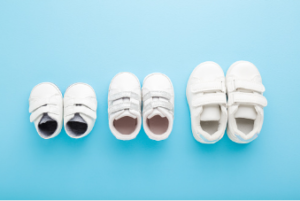Children’s feet develop quickly, so their shoes must provide maximum comfort and durability. Look for shoes made from breathable materials with flat soles that make walking easy. Check the kids shoes clearance sale for collections.
Children’s feet need freedom of movement, so ensure their shoes have wide-toe boxes without heel raisers and are the right size. Also, be sure they fit them comfortably!
Style
 Kids love dressing themselves, and shoes are an easy way to express their individuality. From high-tops for sports to slippers for around the house, there’s sure to be an option that perfectly embodies them – look out for styles with their favourite characters, patterns or colours and ensure it’s easy for them to put them on themselves!
Kids love dressing themselves, and shoes are an easy way to express their individuality. From high-tops for sports to slippers for around the house, there’s sure to be an option that perfectly embodies them – look out for styles with their favourite characters, patterns or colours and ensure it’s easy for them to put them on themselves!
Shoes should fit properly to prevent blisters, calluses or corns in children. Physical growth occurs rapidly during childhood, impacting their feet; too-small footwear could force children into an unnatural gait that leads to knee, hip and back issues in adulthood; too-big footwear would allow too much pressure on toes, which is detrimental in both cases.
The rule of thumb suggests leaving approximately one thumb-width of wiggle room between the front of a shoe and its longest toe for proper foot expansion and support of crumpling or collapsing under pressure.
Comfort
Children have active feet, so shoes that allow their feet to breathe are ideal. Consider materials like canvas, leather, or mesh to keep their feet cool and comfortable all day. Check the kids shoes clearance sale for collections.
Kids require flexible shoes to walk, run and jump efficiently. Look for shoes with flexible soles and rounded toe boxes to allow their toes to spread out comfortably in comfort. Too tight shoes can pinch toes or put them at risk of blisters; too large shoes can rub against the back of the heel easily or come off easily while providing no support for movement.
Shop for your child’s shoes together if possible so that you can ensure they fit properly. A simple way to test this fit is for them to walk around in them – as one foot may differ in size, you should ensure there is room in their shoe for it. When considering shoe sizing for children, it’s also important to remember that their feet can change shape as they grow and consider any extra padding or inserts they might need; have their feet measured every two to three months to ensure that their shoes continue fitting well!
Durability
Many children’s shoes look fantastic when first purchased but quickly wear down over time due to rapid foot growth – toddlers from age three experience an average foot size increase every 2-3 months! Conversely, shoes explicitly designed to facilitate the natural development of young feet will prevent future issues with foot health.
The ideal kid’s shoes should cradle children’s feet and mimic the arch shape of their natural feet rather than one pre-moulded to them. It allows their feet to feel the ground for proper development while avoiding rigid soles, restricting movement and eliminating sensory feedback. Furthermore, its topline should never touch or rub against ankle bones.
These lightweight sneakers provide durability and style for bold or shy kids, drying quickly while featuring an easy slip-on closure system for self-putting on. Check the kids shoes clearance sale for collections.
Activity
Children can use shoes to develop various skills. For instance, most children won’t be able to put their shoes on until around 36 months old at the earliest – making this an opportunity to practice fine motor skills and learn independence while sitting while putting on their footwear and socks. You can help develop their balance by encouraging them to sit during this activity.
Older children can be asked to identify different components of their shoes and to explain what each part does, such as learning that an opening exists for their foot and a hole at the top for laces. You could also teach them that shoes often come in pairs or matched sets with one on each foot–this practice of math classifying can be beneficial!
